How to spawn a vehicle
Any player at any time can use Vehicle or Aircraft terminal to spawn a vehicle, provided he can pay the Nanite cost.
Main Battle Tanks and Liberators can always be spawned from terminals at Warpgates. If your faction controls a Tech Plant on your current continent, then you can spawn these vehicles from any Vehicle or Aircraft Terminal. There is a 30 second cooldown between vehicle pulls of the same type.
Players can also spawn directly into a vehicle from the main map, as if they had used the vehicle terminal in person.
- This can be done on any uncontested base with a functional vehicle terminal.
- The player’s last used vehicle loadout will be used for this method of vehicle spawning. If you haven’t spawned this type of vehicle on current session, the first loadout will be used.
- To avoid some nasty bugs, it’s not recommended to pull aircraft from the Warpgate in this manner.
Finally, Light Vehicle and Air Terminals can be constructed by players, and used to spawn some of the vehicles. They will have to pay in both Cortium and Nanites.
Facts and Tips
Vehicle Management menu (default “Page Down”) allows to restrict access to the vehicle, and to kick out individual players.
Player can own only one vehicle at a time. If he spawns another vehicle, the previous one will deconstruct.
Player can transfer ownership of his vehicle to a squad member. Use Vehicle Management menu to set access to “Squad Only”, then exit the vehicle. If a squad member enters the vehicle, they will become the new owner, and will be able to pilot it. The vehicle will not deconstruct if the original owner logs out or spawns another vehicle.
Destroying a vehicle counts as a “kill” for the purposes of weapon medals and directives. Vehicle doesn’t have to be occupied.
Directional damage:
- Tanks take 15% more damage from the sides and double damage from the rear and bottom.
- Valkyries take half damage from the bottom.
- Liberators receive 20% less damage from the bottom.
- All other vehicles take equal damage from all sides.
It’s not important which part of the vehicle is hit, only the shooter’s position relative to the vehicle is important. In other words, if you stand behind a tank, you could hit it in the turret or even tank cannon itself, you will still deal double damage. And vice versa, if you stand to the side of the tank, you could be hitting it in rear armor, and still dealing only 15% more damage.
Burning. Vehicles below 20% Health will start burning and lose health over time. They will also have worse handling. Vehicles with more Health take longer to burn down.
Minimap autodetection. Vehicles will automatically appear on the minimap of nearby enemy players. Autodetection range is 100m for ground vehicles and 250m for aircraft, but it can be reduced and removed by Vehicle Stealth defensive certification. The vehicle can still be spotted, and firing any of the vehicle’s weapon will still make it momentarily appear on the minimap.
Armor type: vehicles have Light or Heavy armor. Lightly armored vehicles can be damaged by infantry small arms fire, whereas Heavily armored cannot.
Vehicles are vulnerable to infantry at close range. Keep your distance to stay safe.
Cert pinata: players receive small XP bonuses for dealing damage to any type of vehicle.
Callout: vehicle pilot can use a V + 0 voice callout to ask nearby infantry to get in the gunner seat.
Switching seats: when you are inside a vehicle, you can use F1 – F12 keys to switch between seats. If a seat is already occupied by another player, he will get a prompt, asking if he wants to switch places with you.
How to be a decent gunner
Switch classes to Engineer. When your vehicle gets damaged, wait for the pilot to drive somewhere safe, and then jump out and help with repairs.
Don’t fire without purpose. Firing can give away your position to enemies, and make your vehicle a target. A good rule of thumb is to fire only on targets that your pilot is firing at, or at enemies who are already engaging your vehicle.
Constantly look around and monitor the minimap. It is your job to make sure that nobody sneaks up on your vehicle. At close range, enemy infantry can be especially dangerous, as they can use explosives that will deal high damage to the vehicle. Don’t be afraid to jump out of the vehicle and engage them with your infantry weapons.
Communicate! Spot any enemy you can see, unless your pilot is clearly trying to sneak up on enemies. Use text and voice chat, as well as voice callouts to coordinate. If your weapon starts running out of ammo, let the pilot know by V + 4 (I need ammo!) callout.
Know your weapon. There are many different secondary vehicle weapons, and some of them are only effective against specific targets. Ask your vehicle pilot if you’re not sure what your weapon does.
Common Vehicle Certifications
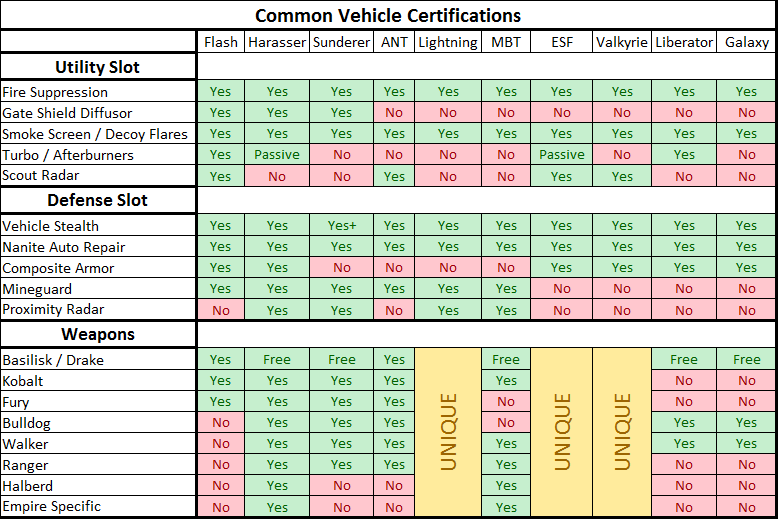
This picture shows which vehicles have access to which equipment, but all of it must be unlocked for each vehicle separately. E.g. unlocking Kobalt for Sunderer will not unlock it for Harasser.
Utility Slot

Fire Suppression – when activated, instantly repairs the vehicle just above the burning threshold, and then slowly repairs it over time for a small amount of health, depending on Fire Suppression Rank and vehicle type (ESFs are repaired more).

Gate Shield Diffuser – when activated, allows a vehicle to pass through enemy base shields and drive across enemy-controlled energy bridges.

Smoke Screen – when activated, for the next 8 seconds the vehicle will continuously emit a thick cloud of smoke, which will prevent the vehicle from being locked-on or appearing on enemy minimap. Allied vehicles within 30m will share these effects.

Turbo / Afterburners – provides an on-demand boost to speed and acceleration by holding the “sprint” key.

Scout Radar – detects movement of nearby enemy infantry in a large radius and relays that information to all nearby players.
Defense Slot

Vehicle Stealth – reduces the distance at which the vehicle will automatically appear on enemy minimap. Increases the time it takes for lock-on launcher to acquire a lock on the vehicle. Reduces the range of enemy Engagement Radar against aircraft.

Nanite Auto Repair – automatically repairs vehicle out of combat, if it’s not burning. Auto-repair is activated in 12 seconds after taking damage (8 seconds for ESFs). The vehicle doesn’t have to be occupied.

Composite Armor – increases vehicle’s base health. Usually, enough to survive an extra rocket or a tank cannon hit.

Mineguard – increases vehicle’s Bottom Armor. It will also specifically reduce Tank Mine damage.

Flanker Armor – a defensive certification for Lightnings and Main Battle Tanks. Provides additional resistance to C4. No other effects.

Proximity Radar – detects movement of enemy infantry in a small radius and relays that information to all vehicle occupants.
Weapons
Many ground vehicles have access to weapons with same names. However, for the purposes of balance, lighter vehicles carry weaker versions of the weapons. Weapons have to be unlocked and upgraded separately for different vehicles.
Secondary vehicle weapons are balanced around their intended effective range – close range weapons have higher DPS than long range weapons.
Common Pool

Basilisk – a medium range high caliber machinegun. The most common and the most versatile vehicle weapon, capable of dealing average damage to all types of targets.

Drake – a variant of the Basilisk, mounted on heavy aircraft. Has slightly lower rate of fire, but remains effective at longer ranges.

Kobalt – fast firing anti-infantry machinegun. Reliable, easy to use, and has excellent effective range. Cannot damage heavily armored targets.

Fury – automatic grenade launcher. It’s a close range light anti-vehicle weapon that still has potential against infantry. Can be tricky to use at range due to low velocity and heavy projectile drop.

Bulldog – a heavy mortar. Effective against infantry, and can damage armored vehicles. Basically, a beefier and slower version of the Fury. It has the strongest single shot splash damage out of all secondary weapons.

Walker – a long range fast firing anti-aircraft machinegun. Limited applications against ground targets due to limited downward aiming angle.

Ranger – a medium range anti-aircraft automatic flak cannon. Its flak rounds will automatically detonate near enemy aircraft and deal indirect damage. Ranger is even less against useful against ground targets than Walker, and has a shorter range, but deals more damage, and is generally more effective at actually killing enemy aircraft.

Halberd – a long range anti vehicle single shot rocket launcher. Also one-shots infantry without Flak Armor on a direct hit.
Empire Specific

Vulcan – close range anti-armor chaingun. Takes a second to ramp up to full rate of fire. Effective against all ground vehicles, passable against infantry.

Gatekeeper – a long range burst fire anti-vehicle rocket launcher. Requires a reload after each burst. Ineffective against infantry.

Marauder – anti infantry automatic grenade launcher. Deals more splash damage than Fury, but less effective against vehicles.

Mjolnir – close range anti-vehicle burst fire grenade launcher. Ineffective against infantry.

Enforcer – medium range recoil-less magnetic dart launcher, effective against ground vehicles.

Canister – anti-infantry shotgun. High damage per shot and good rate of fire. Deals light damage to armored vehicles.

Aphelion – a close range automatic energy weapon, effective against ground vehicles. Takes 1.5 seconds to ramp up to full rate of fire. If the gunner releases the trigger after that, Aphelion will release a highly damaging blade projectile that can pierce through multiple targets within 300m.

Saron – a medium range semi-automatic energy weapon, effective against ground vehicles. At close range, it can be quickly fired to deal a burst of damage, and at long range it can be tap-fired for maximum accuracy.

PPA – automatic energy weapon, effective against infantry. Fires explosive balls of plasma that deal splash damage. Deals light damage to armored vehicles.
Tank Cannons
All tanks have access to different types of cannons:
| Direct Damage | Splash* | Velocity | Reload | |
| AP | Highest | Lowest | Highest | Slow |
| HEAT | Low | Low | Low | Fast |
| HESH | High | Highest | Low | Slow |
Splash* – collectively refers to both strength and radius of Indirect Damage.
Effectiveness against vehicles. All tank cannons are effective against vehicles, each in their own right.
- AP – High velocity gives it the longest effective range and makes it easiest to hit individual shots. But slow reload punishes every miss.
- HEAT – While it has the lowest damage per shot, thanks to fastest reload, it’s only slightly behind AP in terms of Time to Kill. It also makes it more forgiving.
- HESH – Deals almost as much damage per shot as AP, but has a shorter range due to lower velocity.
Effectiveness against infantry. There are two approaches you could take to assessing it.
The ability to kill with splash damage. HESH is a clear winner here.
The ability to kill with one direct shot. Here the combination of Direct and Indirect Damages is important, as well as cannon’s velocity – makes it easier to “snipe” infantry.
| Type of Hit | Direct Hit OHK | Indirect Hit OHK | ||
| Flak Armor | No | Yes | No | Yes |
| Python AP | YES | NO | NO | NO |
| Python HEAT | YES | NO | NO | NO |
| Python HESH | YES | NO | NO | NO |
| Prowler AP | YES | NO | NO | NO |
| Prowler HEAT | NO | NO | NO | NO |
| Prowler HESH | YES | NO | NO | NO |
| Magrider FPC | YES | YES | NO | NO |
| Magrider PC | YES | NO | NO | NO |
| Magrider VPC | YES | YES | NO | NO |
| Vanguard AP | YES | YES | NO | NO |
| Vanguard HEAT | YES | NO | NO | NO |
| Vanguard HESH | YES | YES | NO | NO |
- Flak Armor 1 – reduces Indirect Damage component by 50%.
Ground Vehicles
Flash

Cost: 50 Nanites
Health: 1500
Crew (2): driver/gunner, rumble seat passenger.

Flash is a lightly armored all-terrain-vehicle, commonly used for quick and cheap transportation, though it does have limited combat applications, especially when equipped with a cloaking device.
The rumble seat passenger can rotate 360 degrees and can use all of the personal equipment.
The Flash driver can freelook in third person view, as long as the Flash doesn’t have any weapons mounted. Otherwise, the driver can only look in front of himself in both view modes. Both passenger and the driver are exposed to enemy fire.
Weapons: the Flash can choose from a limited selection of weapons, some of which can even inflict light damage to vehicles. But they all have limited aiming angles and are hard to use on the move.
Additionally, there is one empire-specific weapon per faction:
- M4-F Pillager – the first true flamethrower introduced to the game. As expected, it has a significant negative impact on performance. Flame projectiles pass through infantry and deal some direct and indirect damage, as well as set them on fire for 3.5 seconds. Known for causing damage to the user, and is generally considered ineffective.
- LA7 Buzzard – a pretend artillery weapon. Fires slow projectiles with a heavy drop that deal some direct and indirect damage, but generally not enough to be considered meaningful. By default has a 20m arming distance (projectiles will not produce splash damage), which can be removed with an optional ammo attachment.
- V30-F Starfall – a small scale burst fire variant of the Saron. Deals a good amount of burst damage to vehicles, and can even ambush tanks in vulnerable positions, but requires direct hits to deal meaningful damage to infantry. Most effective when combined with a second player using C4 or a rocket launcher.
Wraith Cloaking Device: a special utility slot, that allows the Flash to be cloaked when piloted by an Infiltrator. This allows the Flash to be effective in hit-and-run attacks, where it moves while cloaked, and briefly engages while stationary. This playstyle is also sometimes combined with rumble seat passengers with anti-vehicle equipment.
Turbo: a utility slot, functions like an on-demand rocket booster, and allows for some daredevil stunts. Mostly used for fun.
C4 Delivery: Flash can be used in a cheap kamikaze-style attack: throw a couple of C4 bricks on your own Flash, and drive it into enemy tank. Jump out before the collision and detonate the C4.
Harasser
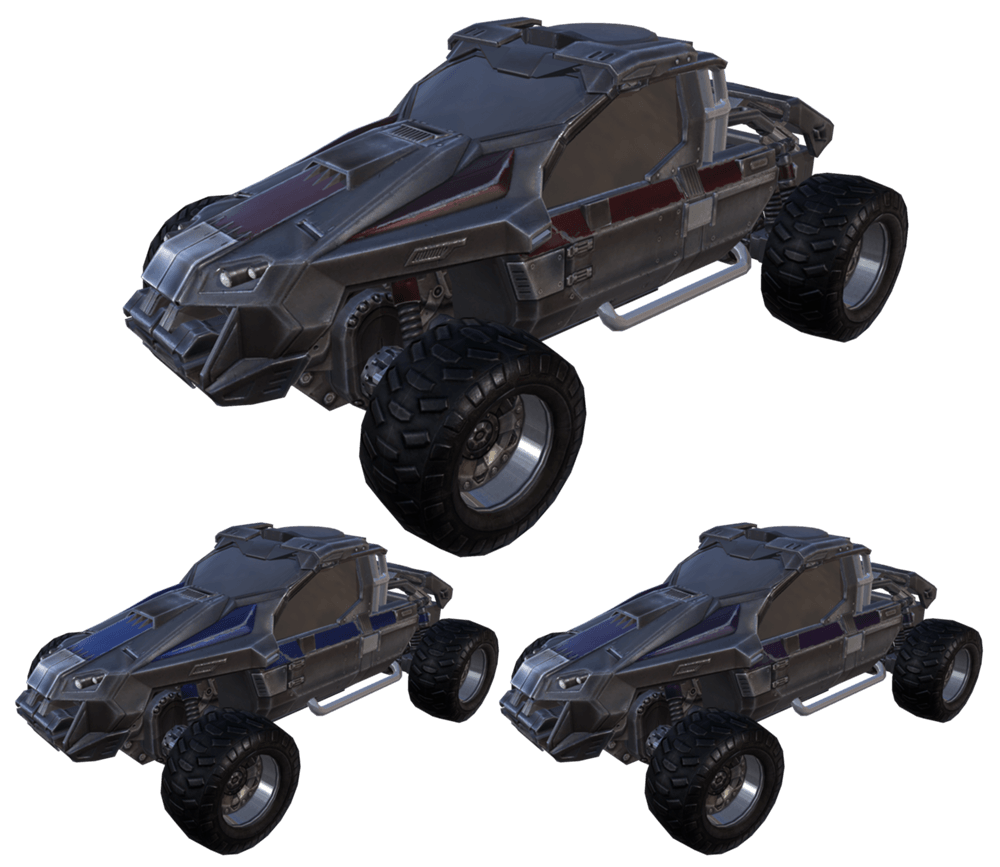
Cost: 150 Nanites
Health: 2500
Crew (3): driver, gunner, back rumble seat passenger.
Harasser is a fast and maneuverable combat buggy, most effective in flanking attacks. It has light armor and can be damaged by small arms fire, but still can survive hits from tank cannons. It can mount a variety of weapons to specialize against any type of target.
Rumble seat passenger can look in the rear hemisphere, and use all personal equipment. Engineers can repair the Harasser from the rumble seat at 30% of the normal repair speed. Repair tool has to be aimed at one of the rear wheels. Can transport a MAX in the rumble seat.
Turbo is a Harasser’s passive system, so it can be used without wasting a utility slot. It allows the Harasser to perform daredevil stunts and quickly get in and out of combat.
Weapons: Harassers can mount all vehicle secondary weapons. They are generally weaker than MBT or Sunderer versions, or have a shorter effective range.
The Basilisk is equipped by default, and funnily enough, it is the only weapon that’s not considered viable on the Harasser, as it simply lacks the necessary firepower.
Harassers usually equip close range anti-vehicle or anti-infantry empire-specific weapons, and try to engage enemy targets at close range, giving preference to flanking attacks and hunting damaged vehicles.
You can read the latest analysis on Harasser’s weapon from one the best Harasser pilots here.
Harassers require good driver-gunner coordination to be effective. The rumble seat is usually kept empty, so in an emergency the gunner can switch to it and repair the Harasser.
Harassers have earned the love and adoration of the community with their daredevil nature, and focus on teamwork, skill and fast decision making. You can bathe in Harasser love and learn how to play them at these resources:
Sunderer
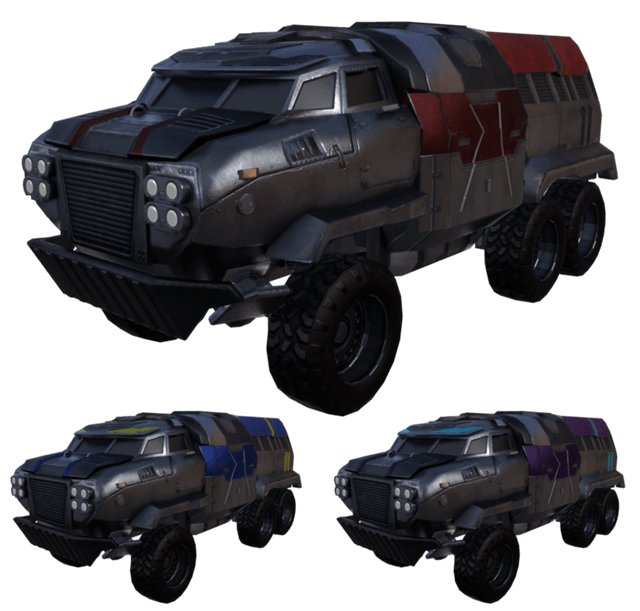
Cost: 200 Nanites
Health: 5000
Crew (12): driver, two gunners and 9 passengers.

Sunderer is a heavily armored vehicle for infantry transportation and vehicle support. Can be deployed to provide a respawn station, which is instrumental in any base attack.
Weapons: Sunderers can mount a variety of weapons, but they are mostly used for self-defense.
Spawning

Mobile Respawn Station: when stationary, the Sunderer can be deployed (default key “B”) to become a respawn station for allied infantry. Deploying the Sunderer also opens access to Infantry Terminals on its sides.
Sunderers cannot be deployed in No Deploy Zones around enemy bases, which ensures the attackers cannot just impudently deploy Sunderers on top of bases’ Capture Points. Deploying a Sunderer also creates a No Deploy Zone around it. No Deploy Zones are marked as red and white circles on your minimap.
Deployed Sunderers have only 15m range of minimap auto detection, so once they are deployed, they will be harder to find for enemies.
Squad Spawning – players can spawn directly into a Sunderer piloted by one of their squad members, even if it isn’t deployed. The Sunderer has to be in allied territory, or within 1000m when in enemy territory.

GSD – Gate Shield Diffuser – this utility allows Sunderers to go through base Vehicle Shields. This can be used to bypass the base’s defenses, and deploy the Sunderer in one of the perimeter towers, effectively using it as a garage.
GSD can also be occasionally useful when attacking AMP Stations and Tech Plants, as it allows to get up to a whole squad directly on to the capture point. Can also be used to drive over enemy-controlled energy bridges.
Defensive Options

Cloak Bubble – when equipped with Vehicle Stealth Rank 5, a deployed Sunderer will create a cloaking bubble, concealing the sunderer itself, as well as any nearby allied infantry.
Damaging the Sunderer or using any of its weapons will reveal it for a few seconds. Watch Belthazor’s brief video review, and read Nanite Systems’ field manual.

Blockade Armor – increases Sunderer’s health and additionally makes it more resistant to C4 damage. It’s often used in “Battle Bus” loadouts. With proper upgrades and crew, a Battle Bus can even take on enemy tanks.

Proximity Repair System – defense slot, repairs nearby vehicles. Doesn’t repair the Sunderer itself. Allied Sunderers are repaired at 50% rate.

Vehicle Ammo Dispenser – defense slot, resupplies ammunition to nearby vehicles.
Deployment Shield

Deployment Shield – a defense slot, that creates a shield over deployed Sunderers. This shield roughly doubles Sunderer’s effective health, and automatically regenerates out of combat. Watch Wrel’s video review.
Base Health and Resistances of the Deployment Shield are currently unknown. Using in-game tests, it has been established that Deployment Shield has:
2500 Effective Health against Damage Type 34 – Infantry Rockets.
This Damage Type is shared by Rocket Launchers, Rocklet Rifle, MANA AV Turret and AV Grenades.
- One C4 Brick deals the amount of damage to Deployment Shield, equal to 1000 damage points from Damage Type 34.
- Tank Mine: just above 900 damage.
- Archer: 4000+ damage.
10 000 Effective Health against Damage Type 28 – Armor Piercing Chainguns.
Other facts:
- Deployment Shield starts recharging in 6 seconds after last taking damage.
- Fully recharges in ~10 seconds after that (untested after CAI)
- Deployment Shield cannot be regenerated while Sunderer is burning.
Deployment Shield changes Sunderer’s Resistance Values and / or Absorbs extra damage upon breaking.
The exact mechanic behind this is unclear, but the point is that if DS receives a huge burst of damage that should have been enough to strip off the shield and kill the Sunderer after that, it won’t actually happen.
For example, 3 Tank Mines is enough to break through the shield, and 2 Tank Mines are enough to kill the naked Sunderer. However, if you were to detonate five mines at the same time, the DS Sunderer will survive with ~80% HP remaining.
So it’s important to deal burst damage in two steps, first to strip the shields, and second to destroy the Sunderer underneath.
ANT
Cost: 200 Nanites
Health:4000
Crew (4): driver/miner, secondary miner/gunner, 2 passengers.
ANT stands for Advanced Nanite Transport. It is a heavily armored mining and construction vehicle. Full information about ANT is available in the Construction System Guide.
The driver controls a mining tool in front, and there’s another mining tool on top of the ANT, which can be replaced by a secondary weapon. ANTs have the same weapon selection as Sunderers.
ANT can be deployed to provide access to a Construction Terminal, which can be used to build fortifications and other objects.
Lightning
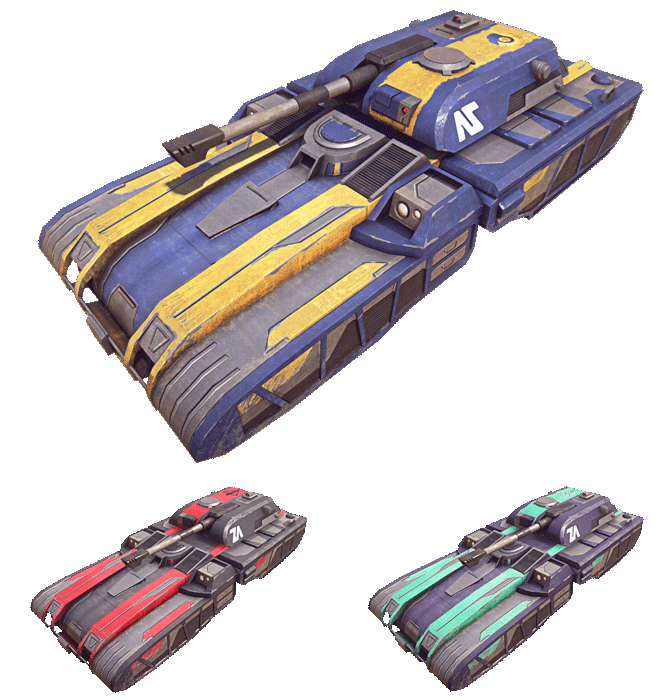
Cost: 350 Nanites
Health: 4000
Crew (1): driver/gunner.

Lightning is a one-manned tank. It is heavily armored, fast and can specialize against any type of target. It loses to fully-crewed MBTs in direct confrontation, so the Lightning has to rely on flanking attacks or numerical superiority.
Weapons: by default, Lightning uses C75 Viper, a close range anti-vehicle auto cannon. Viper can be replaced by a single shot Python cannon, specialized against infantry or vehicles, or the Skyguard – a rapid fire Flak Cannon.


Main Battle Tanks
MBTs are heavily armored Main Battle Tanks. They are different for each faction. MBTs can always be spawned at a Warpgate. To be able to spawn them at other bases, your faction has to control a Tech Plant on your current continent.
Having a filled gunner seat is extremely important for MBTs. Otherwise, they can potentially lose in straight up combat even to a Lightning.
Cost: 450 Nanites
Crew (2): pilot/main gunner and secondary gunner.

Prowler
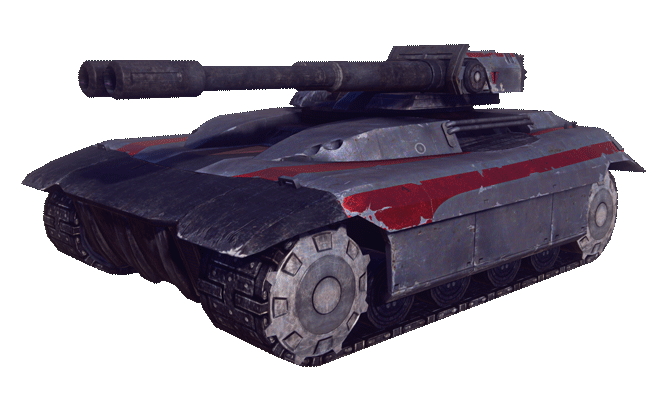
Health: 5000

Prowler is a mobile artillery unit. Its dual cannons can sustain a high damage output, and Prowler can boost the firepower even further. Prowler has the highest cruising speed and smallest hit box.

Built-in ability: Anchored Mode – Prowler can anchor itself in place to gain a massive boost to projectile velocity of its main cannon. Secondary weapons aren’t affected.

Unique Ability: Barrage – when activated, increases the reload speed of Prowler’s main cannon by 30%. 60 / 50 / 47 / 45 second cooldown, costs 100 / 200 / 500 / 1000 Certs to unlock.
Prowler is the best tank for soloing, because it can deal high damage to vehicles even without a secondary gunner, so the secondary weapon slot can be dedicated to an anti-air weapon for self defense.
Vanguard

Health: 6000
 Vanguard is a classic heavy tank. It has the most health and the most powerful single-shot cannon. Low rate of fire makes it crucial to hit every individual shot.
Vanguard is a classic heavy tank. It has the most health and the most powerful single-shot cannon. Low rate of fire makes it crucial to hit every individual shot.
 Unique ability: Forward Vanguard Shield – when activated, this ability will reduce incoming damage from top and front by 67%, and by 34% from the sides. Lasts 8 seconds.
Unique ability: Forward Vanguard Shield – when activated, this ability will reduce incoming damage from top and front by 67%, and by 34% from the sides. Lasts 8 seconds.
This ability allows Vanguards to decisively win straight up engagements with other tanks.
Magrider

Health: 5000

Magrider is a hover tank. It uses a magnetic levitation system, which enables it to strafe to dodge enemy fire, and makes it good at climbing, and generally great at switching the direction of movement.
Magrider has a fixed main turret, so it can fire only at targets targets directly in front of it. The driver’s third person camera is also fixed, and cannot be used to look around.
Due to both of these factors, Magrider pretty much requires a secondary gunner to be safe from flanking attacks and to be effective on the battlefield.
Magrider is stable on the move, and its cannons have zero recoil, so inside a firefight, it is the most mobile tank. However, when simply moving around, Magrider is actually the slowest MBT, and it also has the largest hitbox.
Overall, it’s often said that Magrider plays like a heavy Harasser. Flanking, ballsy positioning and having a good gunner are mandatory for any Magrider.
 Unique ability: Magburner – gives the Magrider a short burst of speed and levitation height. Can be used to engage or disengage, as well as to move over otherwise impassable terrain.
Unique ability: Magburner – gives the Magrider a short burst of speed and levitation height. Can be used to engage or disengage, as well as to move over otherwise impassable terrain.
Tips for MBTs
Aircraft
Aircraft Handling Basics
PlanetSide 2 aircraft are unique. All of them are capable of Vertical Take-Off and Landing, and are equipped with jet engines that will automatically adjust orientation based on your speed.
- If you fly slowly, engines will turn downwards and you will switch into hover mode.
- If you accelerate, engines will turn backwards, and you will be in horizontal flight mode.
Controls
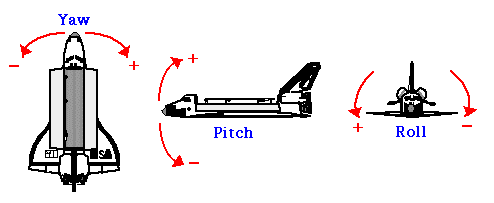
- Move mouse left and right to roll.
- Move mouse up and down to pitch.
- A and D to yaw.
- W and S to accelerate or decelerate.
- Shift to engage Afterburners.
- Space for upward vertical thrust.
- Ctrl for downward vertical thrust.
- = for analog throttle (air brake).
- T to switch between 1st person and 3rd person view.
- Hold middle mouse button and move the mouse to look around in first person view.
To land, decelerate to minimum speed, and let your aircraft slowly descend. If necessary, tap Spacebar to make sure you’re not falling too fast. The landing gear will extend automatically when you are near the ground. Press air brake (=), and tap accelerate (w) once. This will let your aircraft gently land.

To fly faster, angle your aircraft slightly downwards, and hold Space.
In general, flying is considered one of the hardest activities in PlanetSide 2, so don’t be discouraged if you fail a lot, and hopelessly crash your first few dozen of ESFs.
Empire-Specific Fighters
Empire Specific Fighters are lightly-armored one manned jets, capable of vertical take off and landing. They are different for each faction, and can be specialized against air or ground targets.
Cost: 350 Nanites
Health: 3000
Crew (1): pilot.
ESFs have light armor, so they can be damaged by small arms fire, and flak hurts them a lot. However, they are fast and bursty, so without anti-air on stand-by, you can’t do a lot against them from ground.
ESFs can only engage targets directly in front of them, so they’re vulnerable from sides and rear.
Your starting ESF loadout includes a nosegun and External Fuel Tanks, which increase Afterburner fuel capacity. This loadout is only suitable for moving around or engaging other aircraft. Don’t even try attacking ground targets with it, it’s a waste of time.

Afterburners: all ESFs have afterburners as a passive system, which gives them an on-demand access to a burst of speed and acceleration. Using afterburners is a requirement for Reverse Maneuver, which is a basic move in dogfighting.
Primary Weapon: nosecannons. Mainly used against other aircraft, but they’re capable of dealing damage to heavily armored ground vehicles as well. There is also one anti-infantry nose-cannon per faction.
Secondary Weapon: various air-to-air and air-to-ground rockets. They can be heat seeking, use lock-on mechanics, laser guided or dumbfired.
Various External Fuel Tanks can be used instead of a secondary weapon to increase afterburner fuel capacity and/or recharge rate. This is mostly useful when the ESF is used just for transportation, but many elite pilots choose Fuel Tanks to be able to perform multiple Reverse Maneuvers back to back during dogfights.
Whale hunters: ESFs are effective at hunting Liberators and Galaxies, especially if they don’t have escorts and means of self defense against aerial threats. Tomcat / Photon A2A lock on missiles are especially effective in that role.
Automatic repairs: if an ESF is piloted by an Engineer, it will automatically repair in 12 seconds after taking damage. Repair speed is equal to Nanite Auto Repair Rank 1. This effect does stack with NAR itself.
Improved Nanite Auto Repair: normally, NAR activates in 12 seconds after taking damage. For ESFs, this delay is reduced to 8 seconds.

Engagement Radar: all ESFs have Engagement Radar as a passive system, which automatically spots nearby aircraft, and shows direction to them when they are off screen.

Ejection Seat – allows the pilot to safely eject from the ESF at any height. The Ejection Seat will remove the effects of ESF’s momentum from the pilot, and protect them against any fall damage.
Ejection Seat is sometimes used to stealthily deliver single operatives in key positions.
Mosquito

 Mosquito has high rate of fire weapons with sustainable fire, and can do the most damage in one salvo, but takes the longest to unleash it. Has smallest hit box overall, and highest cruising speed.
Mosquito has high rate of fire weapons with sustainable fire, and can do the most damage in one salvo, but takes the longest to unleash it. Has smallest hit box overall, and highest cruising speed.
Scythe
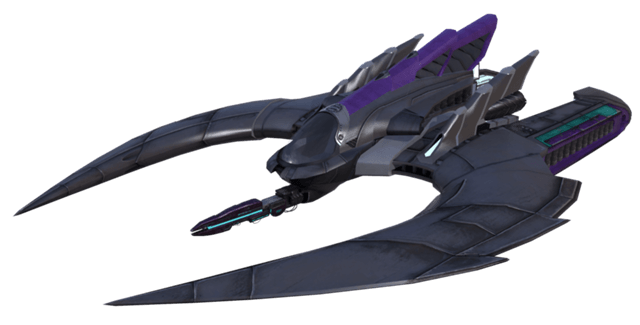

Scythe’s slim frontal profile makes it the most effective ESF in hover duels at range, in the hands of an experienced pilot.
Reaver
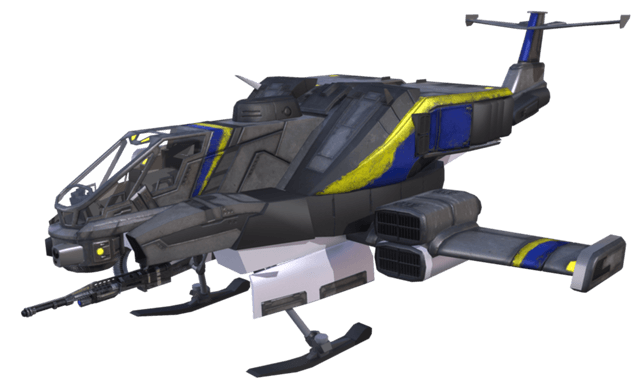

Reaver is the slowest ESF, and has the biggest hit box. However, it has the strongest vertical thrust and afterburners, and its weapons do a lot of damage, especially up close.
Learn to fly ESF
- Wrel’s video about ESF basics.
- Hader’s Comprehensive ESF Guide
- Current state of ESF Balance by Rexoplex
Liberator
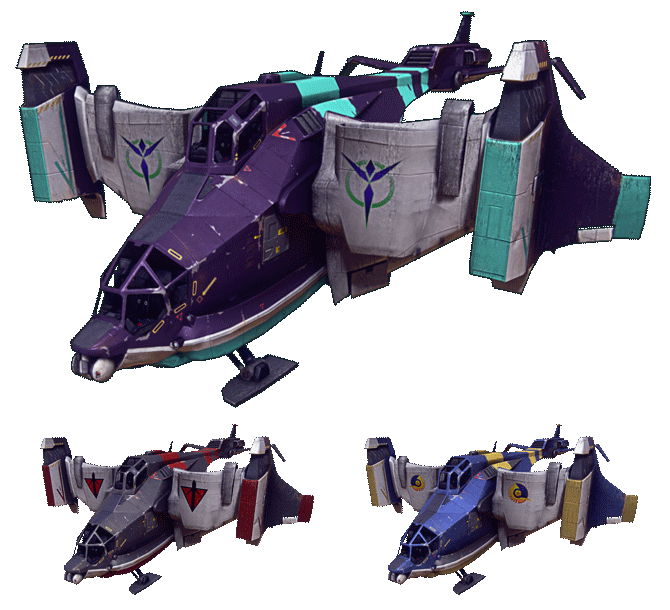
Cost: 450 Nanites
Health: 5000
Crew (3): pilot/nosegunner, belly weapon gunner, tail weapon gunner.

Liberator is a heavy air-to-ground gunship, armed and armored to the teeth. Liberators can can always be spawned at a Warpgate. To be able to spawn them at other bases, your faction has to control a Tech Plant on your current continent.
Liberators are intended to be hover gunships with sustained damage over time against ground targets.
Extended hover: tapping air brake (default key “=”) will make the Liberator hover in place without moving, as long as it’s aligned with the horizon. This effect will be lost if pilot ejects or moves to another seat.
Nosegun freelok: when aiming down sights, all Liberator noseguns can swivel in freelook mode. This makes it easier to hit and track ground targets while hovering.
While in freelook mode, your mouse movement will not control Liberator’s flight, so you won’t be able to aim for very long while not hovering. That said, you can bind all of the aircraft controls to the keyboard, and use the keyboard to correct course while aiming.
Increased bottom armor: Liberators receive 20% less damage from enemies in its bottom projection. When being chased by ESFs, it’s a common tactic to try and force them to hit you in the bottom.

LF-100 Afterburner: similarly to ESFs, all Liberators are equipped with afterburners. By default, it takes 40 seconds to fully regenerate afterburner fuel. This can be upgraded for 100 / 150 / 200 / 400 / 1000 Certs to 30 / 27 / 24 / 22 / 20 seconds.
Galaxy
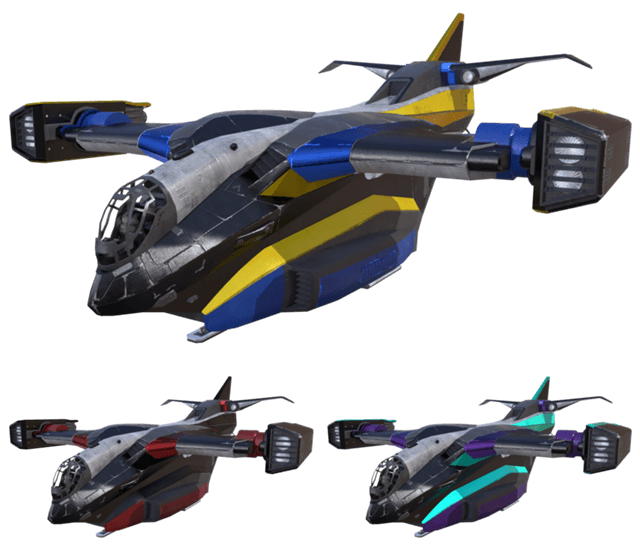
Cost: 450 Nanites
Health: 7000
Crew (12): pilot, four gunners (left, right, top and rear hemispheres) and 7 passengers.

Galaxy is a heavily armored aircraft for transporting infantry and providing support to allied aircraft and vehicles. Galaxies have the most health than any other vehicle, but they are slow and easy to hit, and go down from concentrated fire pretty quickly.
Weapons: by default, Galaxy has general-purpose machineguns mounted on all four turrets, but left and right turrets can use air-to-ground mortars and all-purpose rocket pods, and top and tail turrets can mount anti-air machineguns and AA rocket pods, for self defense and support.
Galaxy Drops: when anyone jumps out of a Galaxy from any height, he is protected from fall damage, so even a completely stock Galaxy can be effectively used to deliver troops wherever needed.
Squad spawning: dead squad members can spawn directly into a Galaxy that is piloted by one of their squad members, as long as it’s in allied or territory or within 1000m.
Galaxy has two most frequent uses:
Galaxy squad drop – the whole squad, including the pilot, uses the Galaxy to drop directly on an objective, such as a generator or a capture point. Galaxy falls down and crashes after the drop.
Battle Galaxy – most of the squad drops on the objective, and the Galaxy remains occupied by skeleton crew – pilot and one or several gunners. Galaxy continues to float or circle above the objective, and dead squad members can deploy in the gal and drop once again, while the gunners provide fire support from above.
Support-oriented defensive slots:
 Vehicle Ammo Dispenser – resupplies ammunition to nearby ground and air vehicles. 50 / 100 / 200 / 500 Certs to unlock, works within 50 / 75 / 90 / 100 meters.
Vehicle Ammo Dispenser – resupplies ammunition to nearby ground and air vehicles. 50 / 100 / 200 / 500 Certs to unlock, works within 50 / 75 / 90 / 100 meters.
 Nanite Proximity Repair System – automatically repairs nearby ground vehicles within 50m and air vehicles within 75m. 100 / 150 / 200 / 400 / 500 / 1000 Certs to unlock, repairs 25 / 50 / 75 / 100 / 125 / 150 Health per second.
Nanite Proximity Repair System – automatically repairs nearby ground vehicles within 50m and air vehicles within 75m. 100 / 150 / 200 / 400 / 500 / 1000 Certs to unlock, repairs 25 / 50 / 75 / 100 / 125 / 150 Health per second.
 Lockon Jamming Field – blocks lock-on attempts on nearby vehicles. 50 / 100 / 200 / 500 Certs to unlock, works within 100 / 125 / 140 / 150 meters.
Lockon Jamming Field – blocks lock-on attempts on nearby vehicles. 50 / 100 / 200 / 500 Certs to unlock, works within 100 / 125 / 140 / 150 meters.
None of these abilities have any effect on Galaxy itself.
Valkyrie
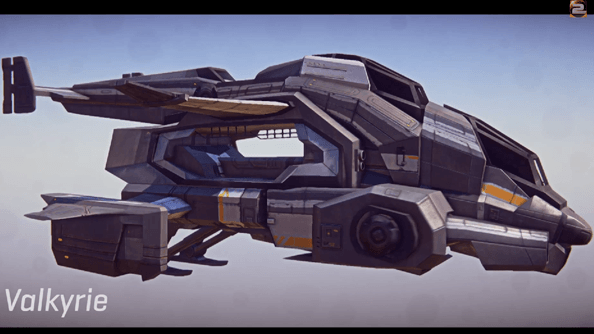
Cost: 250 Nanites
Health: 3000
Crew: pilot, gunner, and 4 passengers on rumble seats. Cannot transport MAXes.
Valkyrie is a small, lightly armored air transport vehicle. Mostly used for Scout Radar services and Squad Spawning, being able to repeatedly drop squadmembers on roofs and balconies. They also offer cheap transportation to small squads and close air support.
Weapons: one 360 degree view turret is mounted on lower front side of the Valkyrie. By default it’s a general-purpose machinegun, but it can be replaced by a variety of specialized anti-infantry and anti-vehicle weapons. Valkyries weapons are generally about as powerful as an ESF weapon.
Squad Spawning and Safe Fall: similar to Galaxies, Valkyries grant fall damage protection to anyone who jumps out of them, and squad members can respawn inside a Valkyrie piloted by a squad member, as long as it’s in allied territory, or within 1000m.
Rumble seats: passengers on rumble seats can use all of their personal equipment, but they remain vulnerable to enemy fire.
Rumble seat repairs: an engineer in a rumble seat can repair the Valkyrie at 60% of normal rate. Only one engineer can be repairing at a time.
Small arms resistance: Valkyries take 90% reduced damage from most bullet-type infantry weapons. For comparison, ESFs have 75% resistance.
Bottom armor: Valkyries take 50% reduced damage from the bottom projection.
Other resources
- You can learn a lot about tanks at Armorpedia
Credits
Huge thanks to the amazing PlanetSide 2 community members, who contributed many suggestion on worthwhile early vehicle certifications in this thread:
Hader102, Hell_Diguner, calisai, tacularcrap, DasHaussaa, st0mpeh, Aloysyus, RexCL, ShadowInsignus, RubberDough, MrLayZboy, kszyhon, TestMir954, Withstand_Connery, Mentleman, Xerox1231, Bvllish, drxxdumazz, Skrewie, shanterlad, moewillis2, McLegendd.
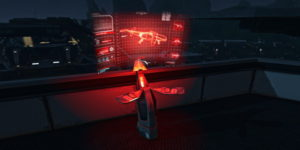
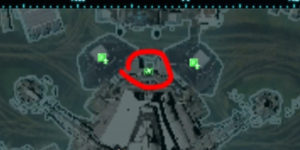
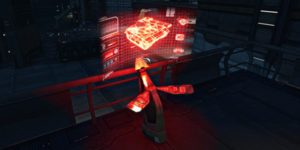

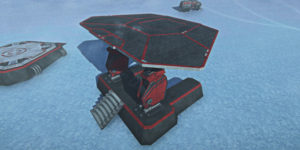
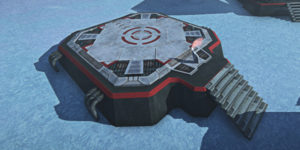
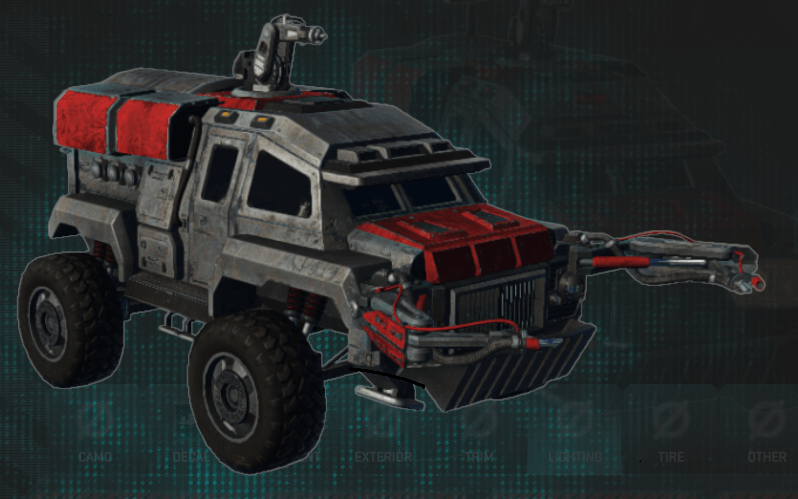
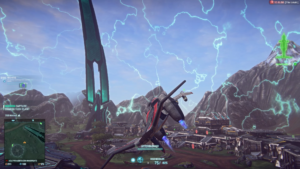
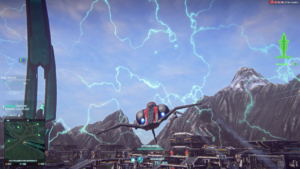
Dear Iridar, I found a mistake. Maybe due to some later update. On Prowler you wrote:
“Built-in ability: Anchored Mode – Prowler can anchor itself in place to gain a massive boost to projectile velocity of its main cannon. Secondary weapons aren’t affected.”
It is called “Barrage” now. Giving reload speed 30% for the Prowlers main cannon. Same applies to NC and VS in their specific abilities .
Don’t want to be pedantic or so, I guess you have it on your radar already. I’m a huuuuuuugeee fan of you work and your videos. Please keep doing what you do, because you’re awesome and deliver awesome stuff!
Best wishes
Institoros, Miller TR
Anchored Mode is Anchored Mode, Barrage is Barrage. These are two separate abilities. First is built-in into Prowler and increases projectile velocity when Prowler is deployed. Second is a temporary reload speed boost.
hey just wonder what chasis are good for the flash with a weapon? the control one with better turns or hill climbing with better stability? the racer one is too slippery for me to handle but if its better, please let me know
The best chassis for general purpose combat is the Scrapper chassis. It will help you out turn enemy vehicles without slipping as much and hopefully let you turn out of a bad situation more effectively than any other chassis. This chassis will do very well in tight corners of amp stations and tech plants. Be wary though that you’re not going to out run vehicles or enemy ironsights out in the open. Be sure to utilize cover as much as you can.
The Racer chassis is more for advanced drivers that can effectively use the E-brakes to turn/drift and feather the direction keys with great timing for better control. It’s good for “boom-n-zoom” tactics if you want to fight the enemy in close quarters then escape as quickly as possible. This chassis is best used in open areas, but it’s best to avoid open areas for extended periods of time as you’re still a flash and can be outran/ran down by almost all vehicles. But remember it only gives +10kph at max certification (700 certs); 75kph -> 85kph. A harasser has 90kph -> 108 kph.
The Surger chassis is not that great as the Racer chassis has just as good hill climbing due to higher top speed and acceleration. The only upside of the surger is that you get a built in suspension that helps stabilize your aim while in both 1st and 3rd person view while on bumpy terrain. This chassis is almost redundant and should be used for transportation or support on steep rough terrain like on Amerish and rocky Indar. That is my opinion but it really isn’t much of a combat friendly chassis.